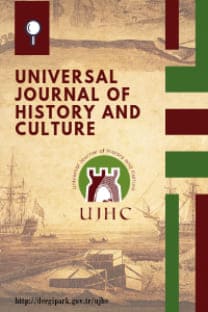Sultan ve Foucault: II. Abdülhamid Döneminde Cuma Selamlığı, Arz-ı Hâller ve İktidarın Mikrofiziğinde “Güç Aşındırmaları” (1876-1908)
Osmanlı Devleti, II. Abdülhamit, M. Foucault, İktidar, Arz-ı hâl, Güç Aşındırması
Sultan and Foucault: The Friday Parade, Petitions, and “Power Corrosions” in the Microphysics of Puissance in the Reign of Abdülhamid II (1876-1908)
Ottoman Empire, Abdulhamid II, M. Foucault, Power, Petition, Abrasion of Power,
___
- Akçakaya, M. (2016). Weber’in bürokrasi kuramının bugünü ve geleceği, Gazi Üniversitesi Sosyal Bilimler Dergisi, 3 (8), 275-295.
- Akyıldız, A. (2018). Osmanlı Bürokrasisi ve Modernleşme. İstanbul: İletişim Yayınları.
- Alikılıç, D. (2004). İmparatorluk seremonisi: Osmanlı’da devlet protokolü ve törenler. İstanbul: Tarih Düşünce Kitapları.
- Aslan, S. ve YILMAZ, A. (2001). Tanzimat döneminde osmanlı bürokratik yapı ve düşüncesinin değişimi, Cumhuriyet Üniversitesi İktisadi ve İdari Bilimler Fakültesi Dergisi, 2 (1), 287-297.
- Aykurt, Ç . (2001). Padişah-halk buluşmasını temin eden törenlerden birisi: Cuma selamlığı, Tarih İncelemeleri Dergisi. 16 (1), 201-204.
- B.O.A. (Başbakanlık Osmanlı Arşivi), İ.DH., 736/60300, 25 Zilkade 1293 (12 Aralık 1876).
- B.O.A., Y..MTV., 261/22, 5 Rebiülahir 1322 (19 Haziran 1904).
- B.O.A., Y.PRK.AZJ., 9/90, 29 Zilhicce 1301 (20 Ekim 1884).
- B.O.A., İ.AZN., 67/26, 3 Cemaziyelahir 1324 (25 Temmuz 1906).
- Berkes, N. (1964). The development of secularism in Turkey. Londra: Hurst & Company.
- Ç aha, Ö. (1994). Osmanlı’da sivil toplum. Ankara Ü niversitesi SBF Dergisi. 49 (2),79-99.
- Demirel, F. (2019). Sultan II. Abdülhamid’in kamusal alanda görünürlüğü. Sultan II. Abdülhamid Dönemi: Siyaset - iktisat - dışpolitika - kültür – eğitim. M. Bulut, M. Enes Kala, N. Salık ve M. Nar (Ed.). İstanbul: İZü Yayınları, 95-111.
- Deringil, S. (2014). İktidarın sembolleri ve ideoloji: II. Abdülhamid Dönemi (1876-1909). İstanbul: Doğan Kitap.
- Ergin, Osman N. (1977). Türkiye maarif tarihi, 3 (4). İstanbul: Eser Matbaası.
- Foucault, M. (1978). The History of Sexuality - Volume I: An Introduction, R. Hurley (Ç ev.). New York: Pantheon Books.
- Foucault, M. (1982). The subject and power. Critical Inquiry. 8 (4), 777-795.
- Foucault, M. (2001). The essential works of Foucault 1954-1984. J. D. Faubion (Ed.). 3. New York: The New Press.
- Foucault, M. (2006). Psychiatric power: Lectures at the Coll`ege de France, 1973-74. F. Ewald ve A. Fontana (Ed.). G. Burchell (Çev.). Londra: Palgrave Macmillan.
- Foucault, M. (2011). Entelektüelin siyasi işlevi – seçme yazılar I, I. Ergüden, O. Akınhay ve F. Keskin (Ç ev.). İstanbul: Ayrıntı Yayınları.
- Foucault, M. (2013). Güvenlik, toprak, nüfus: Coll`ege de France dersleri, 1977-1978. F. Taylan (Çev). İstanbul: İstanbul Bilgi Ü niversitesi Yayınları.
- Galeano, E. Biz hayır diyoruz. B. Kale (Ç ev.). İstanbul: Metis Yayınları.
- Gölbaşı, Ş. (2015). Güvenlik, toprak, nüfus. Mülkiye Dergisi. 39 (2), 327-340.
- Görür, C. (2018). Sultan III. Mustafa’nın Cuma selˆamlıkları, History Studies, 10 (9). 147-155.
- Heyd, U. (1973). Studies in old ottoman criminal law. Oxford: Clarendon Press.
- Houston, R. A., (2014). Peasant petitions: social relations and economic life on landed estates, 1600-1850. New York: Palgrave Macmillan.
- İnalcık, H. (1988). Şikayet hakkı: ‘arz-ı hal ve ‘arz-ı mazharlar. Osmanlı Araştırmaları, VII-VIII, 33-54.
- İnalcık, H. (2019). Osmanlı fetih yöntemleri. Söğüt’ten İstanbul’a: Osmanlı Devleti’nin kuruluşu üzerine tartışmalar. O. Özel ve M. Öz (Der.). Ankara: İmge Kitabevi. 443-472.
- İpşirli, M. (1991). Arzuhal. TDV İslam Ansiklopedisi. 3, s. 447-448.
- İpşirli, M. (1991). Osmanlılarda Cuma Selamlığı (halk hükümdar münasebetleri açısından önemi), Prof. Dr. Bekir Kütükoğlu’na armağan. İstanbul: Edebiyat Fakültesi Basımevi, 459-471.
- İstanbul Üniversitesi, Nadir Eseler Kütüphanesi, II. Abdülhamid Han Fotoğraf Albümleri, yer no: NEKYA90817/10.
- Karaman, K. (2010). Ritüellerin toplumsal etkileri, SDü Fen Edebiyat Fakültesi Sosyal Bilimler Dergisi, 21, 227-236.
- Kemper, Theodore D. (2011). Status, power and ritual ınteraction: a relational reading of Durkheim, Goffman and Collins. Surrey: Ashgate.
- Lynch, Richard A. (2011). Foucault’s theory of power, Michel Foucault: Key Concepts. D. Taylor (Ed.). Durham: Acumen Publishing.
- Mardin, Ş. (1991). Türkiye’de toplum ve siyaset - makaleler 1. M. Türko¨ne ve T. O¨ nder (Der.). İstanbul: İletişim Yayınları.
- Mark, Gregory A. (1998). The vestigial constitution: the history and significance of the right to petition. Fordham Law Review, 66 (6), 2153-2231.
- Mills, S. (2005). Michel Foucault. New York: Routledge.
- Patton, P. (1994). Foucault’s subject of power. Political Theory Newsletter. 6 (1), 60-71.
- Sakaoğlu, N. (1995). Cuma Selamlığı, Skylife, 112.
- Sanz, Manuel Serrano Y. (1979). Türkiye’nin Dört Yılı, 1552-1556. A. Kurutluoğlu (Ç ev.). İstanbul: Kervan Kitapçılık.
- Taşçı, F. (2014). A psycho-social solution to problems related to social assistance recipients: ‘sadaqa stones modeling’. İstanbul Üniversitesi İktisat Fakültesi Mecmuası, 64 (2), 89-108.
- Van voss, Lex H. (2001). Introduction. Petitions in Social History, L. Heerma van Voss (Ed.). Cambridge: Press Syndicate of the University of Cambridge, 1-10.
- Würgler, A. (2001). Voices from among the “silent masses”: Humble petitions and social conflicts in early modern central europe, Petitions in Social History. L. Heerma van Voss (Ed.). Cambridge: Press Syndicate of the University of Cambridge, 11-35.
- ISSN: 2667-8179
- Başlangıç: 2019
- Yayıncı: Orhan TURAN
Fransa’nın 1860 Lübnan Krizine Müdahalesi
Zeynep YAMAN, Bekir Sadık TOPALOĞLU
Toplumsal Değişimin Bir Göstergesi Olarak Gençlerin Evliliğe Yönelik Tutumları
Mehmet ERKOL, Meryem ŞAHİN, Şehriban AVCI
Erken Cumhuriyet Döneminde Türk Ontolojik Güvenliği: Kimlik, Rejim ve Devlet
Yusuf Ziya BÖLÜKBAŞI, Gökberk YÜCEL
